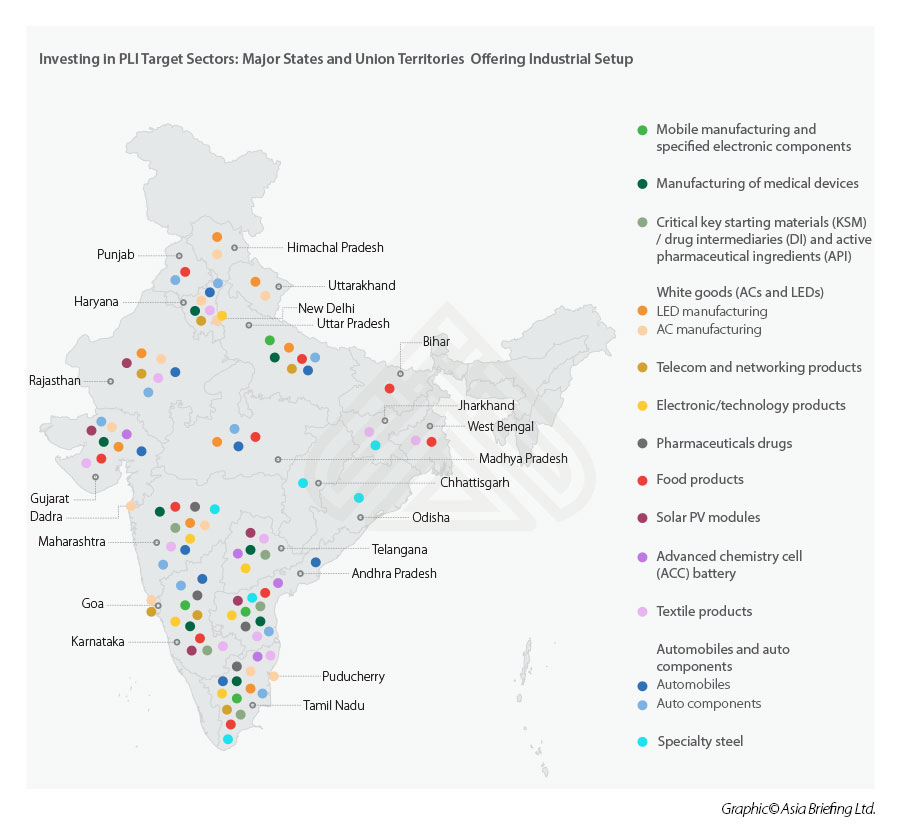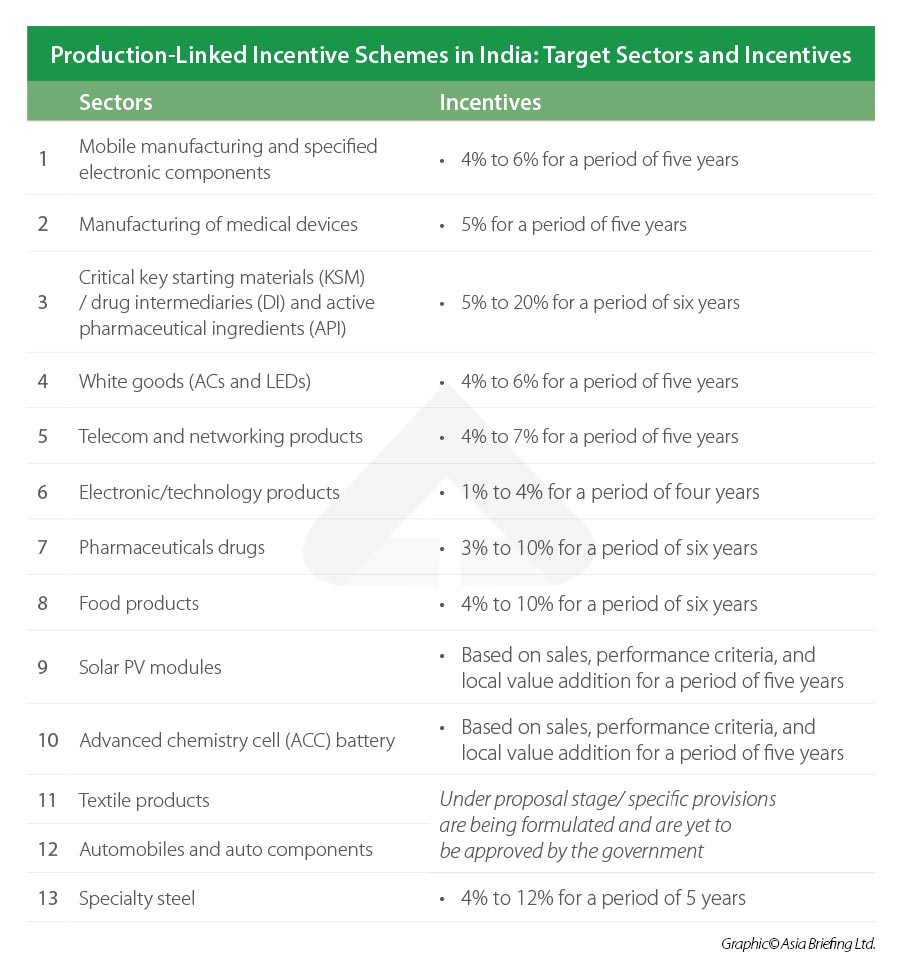India’s Improving Investment Climate For Manufacturing
Over the last decade and a half, India has made significant strides in improving its business ecosystem. Major infrastructure projects have been launched to ensure greater connectivity between states, establish regional industrial ecosystems, and logistics hubs.
Besides these developments, a key focus of the federal government since 2014 has been making improvements on indices that measure the ease of doing business in the country. Consequently, respective states in India have revamped their bureaucratic procedures and systems to implement business-friendly policies and a digital model of governance.
In addition, India is also aspiring to build up its capacity for value added manufacturing to reduce import dependencies and participate actively in the global industrial supply chains. Towards this, specific incentives have been advanced, including tax breaks and financial inducements, for sunrise sectors and labor-intensive industries. India also offers tax breaks based on the existing levels of development in a zone in major industrial states, tax incentives on capital expenditure in specified business areas. The corporate tax rate was reduced in 2019 to benefit manufacturing companies.
Most recently, the government has approved production-linked incentives with a view to create multiple higher value industrial hubs across the country in key sectors; these could be relevant to the economy of the future (electric mobility, high-tech innovation), substitute imports (electronics, drugs, and pharmaceuticals); or create jobs (food processing, auto).
India’s Industrial Value Chain: Major Hubs
Given that India has a federal government, foreign companies choosing where to set up in any of India’s states should note that each region has its own set of industrial policies and incentive schemes.
The applicability of incentives usually varies on the basis of the state’s location, the products that will be manufactured, the scale of investment, and the creation of jobs.
Incentives for capital investment could include reimbursement in the form of subsidies (capital and interest subsidy, land rebate). Incentives to relieve burden on expenditure incurred could include exemptions on government payments for electricity duty, stamp duty, and external development charges as well as reimbursement in the form of employment generation subsidies.
Finally, states may also provide GST subsidy on sales made through GST refund and/or investment promotion subsidy.
Introduction To The Production-Linked Incentive Schemes
For companies interested in or already manufacturing in India, the country’s Production-Linked Incentive (PLI) Scheme gives financial incentives to domestically manufactured products in certain target sectors based on the value of their committed investment, product innovation and addition to the existing value chain, and incremental sales of finished output. Cumulatively, the various PLI schemes are expected to boost domestic manufacturing, increase exports, and attract more FDI inflow by inviting both foreign and local companies to set up, engage in R&D, or expand their manufacturing units in the country.
With the PLI’s coverage ranging from a period of four to six years, depending on the sector, companies interested in applying to the scheme (where the deadline is forthcoming, such as the specialty steel sector) are advised to act as soon as possible.
However, to take full advantage of its benefits, it is also necessary for interested companies to understand the nuances of each target sector’s scheme and whether it aligns with their long-term strategy in India.
Moreover, foreign investors should note that even if their own eligibility for these time bound schemes has lapsed (as they are fund-based ensuring only a limited number of beneficiaries) or companies are not able to meet the set criteria, successful PLI beneficiaries will already be creating key value segments in the industrial supply chain in India. They may prove to be viable business partners or investment targets.
In the table below, we share key features of the PLI schemes, including target sectors, incentive percentages, and incentive periods.
Target Sectors For PLI (as of July 2021)
Investment Facilitation In India
A sense of competitiveness has set in among Indian states to improve the quality of investment growth in their respective jurisdictions. Another objective is the creation of job opportunities, such as through expanded manufacturing capabilities, to prevent the outmigration of talents to other states. Leading industrial states like Maharashtra, Karnataka, and Telangana also have investment facilitation agencies associated with the government that smoothen the corporate establishment process.
Many Indian states have also set up a Single Window Portal that functions as a common point of contact for starting a business and to secure permits and approvals from relevant government departments.
Most states permit users to register for online services across departments, such as land, labor, environment, tax, and utilities. These reforms improve transparency, speeds up investment facilitation, and introduces predictability for businesses. The Department for Promotion of Industry and Internal Trade (DPIIT) also tracks the total (listed) land available for industrial development in India, by state and sector, on its portal.
Besides state-wise improvements to the business climate, most sectors in India are now open to foreign direct investment (FDI) on the automatic approval route. Investments in sensitive sectors, such as defense, media, telecommunication, satellites, civil aviation, and pharmaceuticals, which do require government approval will benefit from a time-bound, transparent, and streamlined process.
The liberalization of India’s investment regulation stems from the acute need to attract greater foreign capital to accelerate growth and achieve developmental objectives. This thrust has in turn been complemented by concerted federal efforts to make India a distinct manufacturing hub in Asia. Most recently, geopolitical factors like the US-China trade war and the COVID-19 pandemic have pushed India to increase its appeal as an FDI destination and a suitable location for multinational businesses seeking to relocate their operations to spread their risks and lower costs.
India strives to present itself as a cost-effective investment destination, offering a vast consumer market, diverse labor force, and mature industrial zones that are well-connected to key regional logistics hubs by port, air, rail, and road.
Top FDI Destinations In India By Sending Country, Target Industry, And Region In FY21
Following a series of policy steps to attract investments into domestic manufacturing and an ambitious infrastructure project pipeline, India received US$81.72 billion in FDI in the financial year 2020-21, the highest ever, and 10 percent more than the previous year. In FY 2019-20, India had attracted US$74.39 billion in foreign direct investment.
Among major investing countries, Singapore accounted for 29 percent of the total FDI inflow into India in FY21, followed by the US at 23 percent and Mauritius at nine percent. Investments from Saudi Arabia rose sharply in FY21 to US$2,816.08 million from US$89.93 million the previous fiscal. Inflows from the US and the UK grew by 227 percent and 44 percent, respectively, in FY21 from the year before.
Among industry beneficiaries, computer software and hardware were the top targets in FY21, accounting for 44 percent share of the total FDI inflow to India. They were followed by construction (infrastructure) activities that accounted for 13 percent and services that accounted for eight percent.
Gujarat topped the list of states attracting FDI, accounting for 37 percent of the total inflows in FY21, followed by Maharashtra at 27 percent and Karnataka at 13 percent. Gujarat received most of the investment inflow into computer software and hardware, representing 78 percent of the total inflows under this classification. India’s IT hubs Karnataka and Delhi attracted a nine percent and five percent share, respectively.
The FDI received in FY21 in the construction, computer software and hardware, rubber goods, retail trading, drugs and pharmaceuticals, and electrical equipment industries was more than the inflow in the previous fiscal year.






Comments